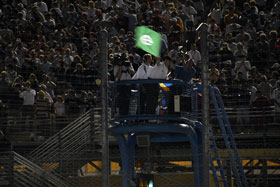President George W. Bush participated in a demonstration of alternative fuel vehicles on the South Lawn drive of the White House Monday with the CEOs of the three largest auto makers.
The president said he “found it very interesting that by 2012, 50 percent of the automobiles in America will be flex-fuel vehicles. That means that the American consumer will be able to either use gasoline or ethanol, depending upon, obviously, price and convenience.”
 Rick Wagoner, Chairman and CEO, General Motors Corporation said that flex fuel vehicles offer the best opportunity right now for America to lessen its dependence on foreign oil. “There are millions on the road today. As a group, we’ve agreed to double our production by the year 2010, and then have 50 percent of our production E85-capable by the year 2012.”
Rick Wagoner, Chairman and CEO, General Motors Corporation said that flex fuel vehicles offer the best opportunity right now for America to lessen its dependence on foreign oil. “There are millions on the road today. As a group, we’ve agreed to double our production by the year 2010, and then have 50 percent of our production E85-capable by the year 2012.”
According to Alan Mulally, President and CEO, Ford Motor Company, there are more ways to help coming soon. “And the fact that we have ethanol solutions today, hybrids coming along, and plus hydrogen and fuel cells and new battery technology, gives some great options to satisfy our need for flexibility, as well as being good stewards of the environment.”
Tom LaSorda, President and CEO, DaimlerChrysler Corporation said their company has “committed, as well, by 2012, to have 50 percent of our production not only in E85, but biodiesel. This Jeep Grand Cherokee here today is going into production as we speak, being shipped from the factory with B5.”
Secretary of Transportation Mary Peters also met with the group.


 Vegetable oil converted to motor-vehicle fuel is considered a biodiesel, which is taxable under state law, said Meredith Helgerson, spokeswoman for the Revenue Department.
Vegetable oil converted to motor-vehicle fuel is considered a biodiesel, which is taxable under state law, said Meredith Helgerson, spokeswoman for the Revenue Department. Ironically, this news comes after the
Ironically, this news comes after the  Montreal, Canada will run its entire bus fleet on biodiesel by 2008 and will buy eight hybrid buses to test in the city’s cold climate.
Montreal, Canada will run its entire bus fleet on biodiesel by 2008 and will buy eight hybrid buses to test in the city’s cold climate. All Société de transport de Montréal (STM) buses will run on biodiesel fuel by 2008, and the transition should be fairly inexpensive, said president Claude Trudel.
All Société de transport de Montréal (STM) buses will run on biodiesel fuel by 2008, and the transition should be fairly inexpensive, said president Claude Trudel. Seattle-based Imperium Renewables, ready to put the country’s largest biodiesel plant into operation and holder of the record for investment in a biodiesel company (see my posts on
Seattle-based Imperium Renewables, ready to put the country’s largest biodiesel plant into operation and holder of the record for investment in a biodiesel company (see my posts on  The official name for Saturday’s IndyCar Series opener may have been the XM Satellite Radio Indy 300, but on
The official name for Saturday’s IndyCar Series opener may have been the XM Satellite Radio Indy 300, but on  Here’s the winner of the first Indy car race of the year, Dan Wheldon. It’s the third time in a row that Dan has won the race. He did it in dominating fashion too and afterward said it was a lot of fun running the race.
Here’s the winner of the first Indy car race of the year, Dan Wheldon. It’s the third time in a row that Dan has won the race. He did it in dominating fashion too and afterward said it was a lot of fun running the race.
 The Team Ethanol car driven by Jeff Simmons is out of the race after what looked like a slide coming out of a turn which turned the car around and then two other cars crashed into it. Fortunately no one was seriously hurt. In fact, they just reported that all three drivers have been assessed and released, so they’re okay.
The Team Ethanol car driven by Jeff Simmons is out of the race after what looked like a slide coming out of a turn which turned the car around and then two other cars crashed into it. Fortunately no one was seriously hurt. In fact, they just reported that all three drivers have been assessed and released, so they’re okay. Here’s Jeff Simmons in the Ethanol Car on the opening lap of the race tonight.
Here’s Jeff Simmons in the Ethanol Car on the opening lap of the race tonight. This year the IRL is giving new meaning to the “green flag.” The official green flag has the ethanol logo.
This year the IRL is giving new meaning to the “green flag.” The official green flag has the ethanol logo. This is the command center for the Rahal-Letterman Ethanol Car seen from trackside just before the race got started. We’ve been hoping the elements would cooperate but it’s a little iffy.
This is the command center for the Rahal-Letterman Ethanol Car seen from trackside just before the race got started. We’ve been hoping the elements would cooperate but it’s a little iffy.